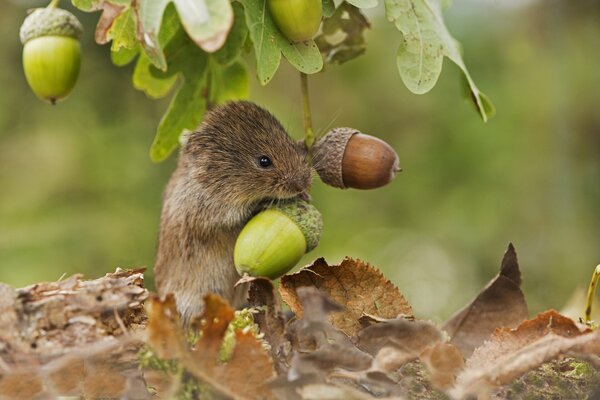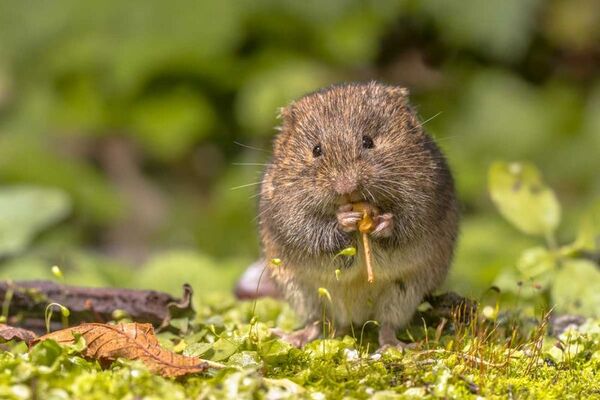Voles are small, burrowing rodents that are often confused with other small animals like mice and rats. However, voles have distinct characteristics and behaviors that set them apart. In this detailed guide, we'll explore everything you need to know about voles, including their species, habitat, diet, behavior, reproduction, and much more. Whether you're curious about the vole's role in the ecosystem or how to handle a vole infestation, this article has got you covered.
Field Vole
Water Vole
Predators of Voles
Voles are small, burrowing rodents that belong to the Cricetidae family, a group also including hamsters and lemmings. Often mistaken for mice or rats, voles have unique traits that make them a distinct species. These small mammals play an important ecological role in the wild. While some may see them as pests, others appreciate the role they play in the food web.

Voles belong to the genus Microtus and there are several species of voles. Some of the most common vole species are the field vole and the water vole.
The field vole (Microtus agrestis) is the most widespread and commonly found species. This vole is primarily found in fields, meadows, and along hedgerows. It has a short, stocky body and a short, furry tail, and typically remains close to the ground.
The water vole (Arvicola amphibius) is commonly found in wetlands and near rivers, lakes, and ponds. This species is larger than the field vole and is often called the "water rat" due to its resemblance to the brown rat. Water voles are known for their excellent swimming skills, and their diet includes plants found in aquatic environments.
Voles are versatile when it comes to habitat. They can live in woodlands, grasslands, and wetlands, but they are especially abundant in areas with dense vegetation, such as grassy fields and meadows. Voles prefer areas where they can easily create their burrows.
These vole burrows are complex tunnel systems that provide safety from predators and shelter from harsh weather. Voles often live in tunnels that lead to different feeding sites, and these burrows can be extensive, sometimes spanning several meters underground.
Voles are herbivores, which means they eat mostly plant material. Their diet consists of grasses, seeds, roots, and other plant-based foods. During the colder months, they may also consume the bark of certain shrubs and trees, particularly when their preferred food sources are scarce.
Voles are also known to feed on tubers and bulbs, which they can find buried beneath the ground. Occasionally, they may eat insects, but plants make up the bulk of their diet. This makes voles an important part of the ecosystem as they help to control plant growth and contribute to the overall balance of the environment.
Voles are nocturnal, meaning they are most active during the night. They are also very territorial, with each vole establishing its own burrow system. These small animals are known for their burrowing behavior, which is essential for their survival. Voles dig tunnels underground to escape predators, store food, and raise their young.
In terms of vole behavior, they are highly active and tend to be more visible during dawn and dusk. Their burrows often have multiple entrances, which gives them a better chance of escaping danger. Voles are also social creatures, living in small colonies within their burrow systems, though each vole will have its own space.

Voles are highly reproductive, and their populations can grow rapidly. Vole reproduction occurs year-round in mild climates, and a single female can produce multiple litters of offspring in a year. The gestation period lasts about 20 days, and each litter can contain between 4 and 6 young.
Voles reach sexual maturity at around 6 weeks of age, and they can begin reproducing shortly after. This rapid rate of reproduction means that vole populations can explode in areas where food is abundant.
Voles have many predators, which helps regulate their populations. The main predators of voles are birds of prey and land-based carnivores.
Birds of Prey: Hawks, owls, and eagles are some of the most common predators of voles. These birds rely on their sharp vision and keen hunting instincts to spot and capture voles, even in dense grass or tall vegetation.
Mammalian Predators: Foxes, weasels, coyotes, and skunks are some of the land-based animals that hunt voles. They typically ambush voles as they venture outside their burrows, using their strong sense of smell and agility.
Domestic Animals: Cats and dogs, particularly those living in rural areas, are often known to hunt voles. They act as natural vole predators, particularly when the rodents venture into gardens or fields near human settlements.
Snakes: Voles are also vulnerable to snakes, such as garter snakes and other ground-dwelling serpents that hunt small mammals.
Though voles are often confused with mice, they are different species with notable distinctions. Here are a few key differences:
Body structure: Voles are stockier and more robust, with shorter, rounder bodies. Mice are typically more slender and agile.
Tail: Voles have short, furry tails, while mice have long, naked tails.
Habitat: Voles are more likely to be found in burrows in grassy or wooded areas, whereas mice are more adaptable and can live in human homes.
While rats and voles might seem similar, especially at first glance, they are distinct species:
Size: Rats are generally larger than voles, with longer bodies and tails.
Tail: Rats have long, naked tails, while voles have short, furry tails.
Habitat: Voles are typically found in natural environments such as forests and fields, while rats tend to live in more urban settings, often near human food sources.
Voles can cause significant damage to gardens. They feed on the roots, stems, and bulbs of plants, potentially killing young plants or disrupting the growth of garden crops. If you have a garden, you may notice signs of vole damage, including chewed-off stems and missing bulbs.
To protect your garden from voles, consider using barriers such as wire mesh around your plants or planting them in raised beds. You can also use vole traps to control their numbers or deter them with natural repellents.
If you're dealing with a vole infestation, there are several ways to manage it. Trapping is one of the most effective methods. You can use live traps or kill traps depending on your preference. Another method is to use rodenticides, although these should be used with care, as they can be harmful to other animals.
Maintaining a clean garden with minimal cover and removing excess vegetation can help reduce the appeal of your property to voles. Additionally, filling in vole burrows and blocking their entrances will help deter them from setting up new homes in your garden.
Despite their occasional role as pests, voles play an essential role in the ecosystem. They are a crucial food source for many predators, including birds of prey and mammals. Their burrowing activities also help aerate the soil, which can promote plant growth.
Moreover, voles are important in seed dispersal and plant control, making them an integral part of maintaining a balanced ecosystem.
In some regions, voles are considered a delicacy and are prepared in various ways. For instance, in parts of Russia and Siberia, voles are sometimes cooked in soups or stews. These dishes may involve boiling the vole with herbs and spices to tenderize the meat, followed by slow cooking in a hearty broth.
In some Asian countries, particularly in China, rodent meats like voles are used in traditional medicine, and their meat is believed to have healing properties.
Here’s a traditional recipe from Siberia:
Vole Stew:
Clean and skin the vole.
Cut the meat into small pieces.
Cook with potatoes, onions, garlic, and a mix of spices (bay leaves, peppercorns, and thyme).
Simmer for a few hours until tender.
Voles are fascinating, small creatures that play a vital role in their ecosystem. Whether you're interested in their diet, behavior, or how to deal with them in your garden, understanding voles helps us better appreciate their place in the natural world. We hope this comprehensive guide has given you all the information you need about voles.
If you're dealing with a vole problem or simply curious about these intriguing rodents, we trust this article has helped you navigate the essentials of vole care, control, and even cooking!
animal tags: Voles
We created this article in conjunction with AI technology, then made sure it was fact-checked and edited by a Animals Top editor.